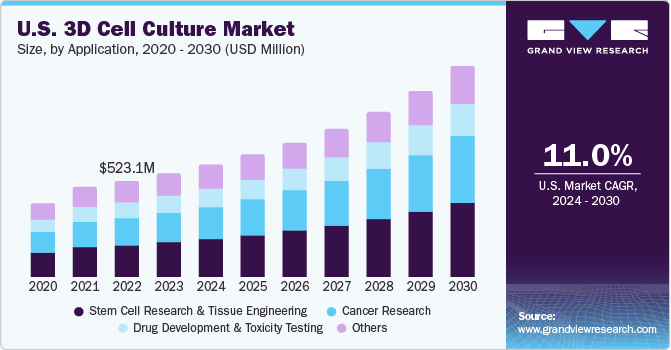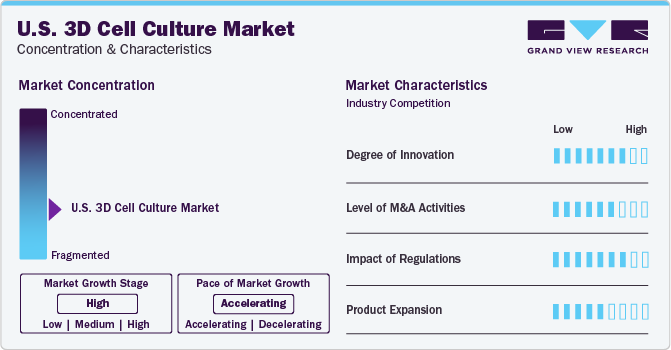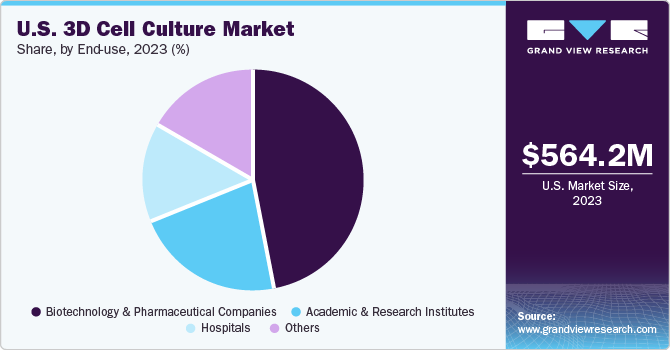- Home
- »
- Biotechnology
- »
-
U.S. 3D Cell Culture Market Size, Industry Report, 2030GVR Report cover
![U.S. 3D Cell Culture Market Size, Share & Trends Report]()
U.S. 3D Cell Culture Market Size, Share & Trends Analysis Report By Technology (Scaffold Based, Scaffold Free, Bioreactors), By Application (Cancer Research, Stem Cell Research & Tissue Engineering), By End Use, And Segment Forecasts, 2024 - 2030
- Report ID: GVR-4-68040-243-7
- Number of Report Pages: 80
- Format: PDF, Horizon Databook
- Historical Range: 2018 - 2023
- Forecast Period: 2024 - 2030
- Industry: Healthcare
U.S. 3D Cell Culture Market Size & Trends
The U.S. 3D cell culture market size was valued at USD 564.2 million in 2023 and is expected to grow at a CAGR of 11.0% from 2024 to 2030. The growth of the market is attributable to increasing availability of funding programs for research and development of potential alternatives for animal-based testing. Further, surge in R&D activities by biopharmaceutical companies for drug development present an opportunity for market growth.

In 2023, U.S. 3D cell culture market accounted for a market share of over 36% of the global 3D cell culture market. The increasing prevalence of chronic diseases is significantly driving the demand for advanced cell culture solutions, including 3D cell culture. Chronic diseases account for most of the healthcare expenditure incurred in this country. As a result, huge chronic disease burden drives the demand for 3D cell culture techniques owing to its wide applicability. Despite considerable improvements in therapies, the incidence rate of diseases has risen significantly, which drives the need for advancements in drug discovery and development. Moreover, the existence of international funding organizations is also anticipated to drive the demand for 3D cell culture systems.
Successful treatment of lymphoma, myeloma, or leukemia and remarkable advances in transplantation have propelled the adoption of regenerative approaches in clinical practices. Hematopoietic stem cell transplants have been proven to be effective treatment options for metabolic storage diseases, immunodeficiency, and extracellular matrix disorders, along with hematological malignancies. Thus, rapid technological advances in the country are expected to influence market growth. Moreover, companies such as Nano3D Biosciences and Thermo Fisher Scientific, Inc., which are engaged in providing 3D cell culture products, are expected to witness significant growth owing to the increasing adoption of 3D cellular models.
Market Concentration & Characteristics
The industry growth stage is high (CAGR >10%) and pace of the growth depicts an accelerating trend. The U.S. 3D cell culture industry is moderately fragmented, which is marked by the presence of large number of companies competing for the market share.

3D cellular models are derived using a variety of structural hydrogels and scaffolds. However, researchers often encounter troubles while cultivating 3D cellular models using scaffolds, as they impede cell-to-cell interactions and interfere with the assembly of extracellular matrices. These drawbacks emphasize the need for technological advancements in scaffold-free technology. Hence, introduction of scaffold-free technology for developing translational pathways for tissues is likely to boost adoption of 3D cell culture solutions. Moreover, the developments in 3D bioprinting, which enables the production of scaffold-free tissue units, are expected to pave the way for the development of functional tissue-engineered constructs with unique 3D structures. Such developments are anticipated to drive the industry growth.
The U.S. 3D cell culture industry is characterized by significant M&A and collaboration activities undertaken by key manufacturers. Key companies are collaborating with other relevant companies to strengthen their portfolio and expand their reach. For instance, in December 2023, Charles River Laboratories announced a strategic collaboration with CELLphenomics. The initiative was aimed at expanding Charles River Laboratories’ in vitro services for drug screening purposes in cancer therapy.
Biotechnology industry regulations in the U.S. are governed by Coordinated Framework for Regulation of Biotechnology established in 1986. This framework outlines the federal policy for regulating products developed with the help of modern biotechnology. The country has three main Federal agencies-the Animal and Plant Health Inspection Service (APHIS), the U.S. Environmental Protection Agency (EPA), and the U.S. Department of Health & Human Services’ Food and Drug Administration (FDA)-which ensure the safe use of genetically modified/engineered organisms. Furthermore, the Centers for Disease Control (CDC), the National Institutes of Health (NIH), and the U.S. Department of Health and Human Services stipulate regulations and recommendations for laboratory biosafety. Similarly, the Occupational Safety & Health Administration (OSHA) sets and enforces standards to protect workers' health & safety in the workplace, including laboratories where cell culture is conducted.
Technology Insights
The scaffold-based segment held the largest market share of 48.9% in 2023. Scaffolds are adopted in 3D cell culture techniques to deliver support for organizing cell cultures. Introduction of advanced tools and technologies is projected to influence revenue growth in this segment. Furthermore, companies including Tecan, Sigma-Aldrich, and others are focusing on providing scaffold-based 3D cell culture solutions and tools, thereby contributing to the growth of the segment.
The scaffold free segment is likely to register the fastest CAGR during the forecast period. Scaffolds can cause interference with cell-to-cell interactions and with the assembly of Extracellular Matrices (ECM) produced by cells. This has driven the demand for scaffold-free 3D cell culture solutions. Development of advanced fabrication techniques to produce scaffold-free engineered organoid constructs is anticipated to drive segment growth over the forecast period.
Application Insights
The stem cell research & tissue engineering segment dominated the market with a share of 34.0% 2023. Stem cell research depends on suitable in vitro cultivation approaches that enable expansion, cryopreservation, and genetic modification of stem cells outside the organism, which is expected to drive the demand for 3D culture-based stem cell research. Moreover, introduction of novel tools in 3D cell culture platform for stem cell-based research is expected to create growth opportunities for the market participants.
The cancer research segment is expected to register the fastest CAGR over the forecast period. Adoption of 3D cellular model for studying cancer biology in preclinical screening and testing as a result of availability of customized microenvironments is expected to increase in the coming years. Moreover, establishment of therapeutic screens coupled with early-stage animal testing is anticipated to drive the segment.
End Use Insights
The biotechnology & pharmaceutical companies segment dominated the market with a share of 46.8% in 2023. Increasing adoption of 3D cell culture system by pharmaceutical companies for drug discovery, toxicity screening, and regenerative medicine is significantly driving the segment growth. Some of the exceptional advantages of 3D cell culture include non-uniform exposure of cells within a spheroid to drug, optimal oxygen and nutrient gradients, and realistic cell-to-cell interactions. These factors have fueled the demand for 3D cell cultures in drug discovery and development.

The academic & research institutes segment is expected to register the fastest CAGR during the forecast period. Culturing cells in vivo to develop models for better understanding of human physiology and anatomy has become a common technique. Rising demand for 3D cell culture systems by research labs and institutes due to their advantages in delivering more relevant information and predictive data for in vivo tests is anticipated to drive the market in the near future.
Key U.S. 3D Cell Culture Company Insights
Key U.S. 3D cell culture companies include Thermo Fisher Scientific, Inc.; Merck KGaA; and Corning Incorporated among others. Leading companies in the market are undertaking strategic initiatives including new product launches, partnerships, and investment activities to fuel the market growth in the coming years.
Key U.S. 3D Cell Culture Companies:
- Thermo Fisher Scientific, Inc.
- Merck KGaA
- PromoCell GmbH
- Lonza
- Corning Incorporated
- Avantor, Inc.
- Tecan Trading AG
- REPROCELL Inc.
- CN Bio Innovations Ltd
- Lena Biosciences
Recent Developments
-
In September 2023, Curi bio unveiled the launch of Nautilus and Stringray platforms. These platforms were intended to help researchers with 2D and 3D cell cultures interrogation on electrophysiology.
-
In June 2023, Lonza entered into a collaboration with Vertex Pharmaceuticals Incorporated. The aim of this strategic initiative was to support the production of Vertex’s range of investigational insulin-producing stem cell-derived islet cell therapies for patients with Type 1 diabetes. This helped speed up clinical trials.
-
In February 2023, Corning Life Sciences announced plans to introduce its innovative 3D culture tools and Elplasia plate. The plate features an open-well format for easy spheroid and organoid operations.
U.S. 3D Cell Culture Market Report Scope
Report Attribute
Details
Revenue forecast in 2030
USD 1.14 billion
Growth rate
CAGR of 11.0% from 2024 to 2030
Actual data
2018 - 2023
Forecast period
2024 - 2030
Quantitative units
Revenue in USD million and CAGR from 2024 to 2030
Report coverage
Revenue forecast, company ranking, competitive landscape, growth factors, and trends
Segments covered
Technology, application, end use
Country scope
U.S.
Key companies profiled
Thermo Fisher Scientific, Inc.; Merck KGaA, PromoCell GmbH; Lonza; Corning Incorporated; Avantor, Inc.; Tecan Trading AG; REPROCELL Inc.; CN Bio Innovations Ltd; Lena Biosciences.
Customization scope
Free report customization (equivalent up to 8 analysts working days) with purchase. Addition or alteration to country, regional & segment scope.
Pricing and purchase options
Avail customized purchase options to meet your exact research needs. Explore purchase options
U.S. 3D Cell Culture Market Report Segmentation
This report forecasts revenue growth in the U.S. market and provides an analysis of the latest industry trends in each of the sub-segments from 2018 to 2030. For this study, Grand View Research has segmented the U.S. 3D cell culture market report based on technology, application, and end use:
-
Technology Outlook (Revenue, USD Billion, 2018 - 2030)
-
Scaffold Based
-
Hydrogels
-
Polymeric Scaffolds
-
Micropatterned Surface Microplates
-
Nanofiber Base Scaffolds
-
-
Scaffold Free
-
Hanging Drop Microplates
-
Spheroid Microplates with ULA Coating
-
Magnetic Levitation
-
-
Bioreactors
-
Microfluidics
-
Bioprinting
-
-
Application Outlook (Revenue, USD Billion, 2018 - 2030)
-
Cancer Research
-
Stem Cell Research & Tissue Engineering
-
Drug Development & Toxicity Testing
-
Others
-
-
End Use Outlook (Revenue, USD Billion, 2018 - 2030)
-
Biotechnology & Pharmaceutical Companies
-
Academic & Research Institutes
-
Hospitals
-
Others
-
Frequently Asked Questions About This Report
b. The U.S. 3D cell culture market was valued at USD 564.2 million in 2023.
b. The U.S. 3D cell culture market is expected to expand at a compound annual growth rate (CAGR) of 11.0% from 2024 to 2030 to reach USD 1.14 billion by 2030.
b. The scaffold-based segment held the largest market share of 48.9% in 2023. Scaffolds are adopted in 3D cell culture techniques to support organizing cell cultures.
b. Key U.S. 3D cell culture companies include Thermo Fisher Scientific, Inc.; Merck KGaA; and Corning Incorporated, among others.
b. The market's growth is attributable to the increasing availability of funding programs for research and development of potential alternatives for animal-based testing.
Share this report with your colleague or friend.
![gvr icn]()
NEED A CUSTOM REPORT?
We can customize every report - free of charge - including purchasing stand-alone sections or country-level reports, as well as offer affordable discounts for start-ups & universities. Contact us now
![Certified Icon]()
We are GDPR and CCPA compliant! Your transaction & personal information is safe and secure. For more details, please read our privacy policy.
We are committed towards customer satisfaction, and quality service.
"The quality of research they have done for us has been excellent."





